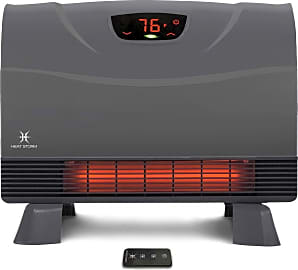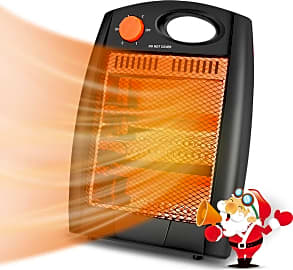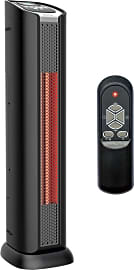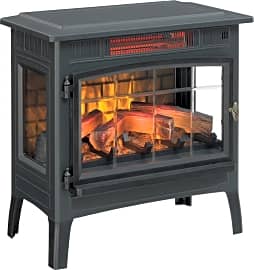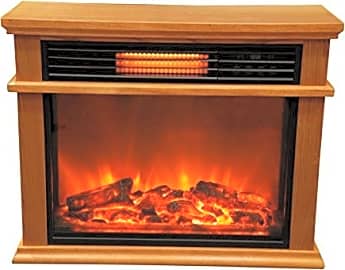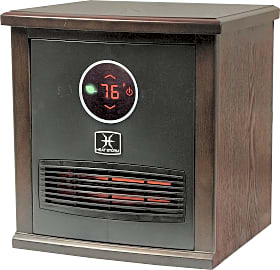The 10 Best Infrared Heaters

This wiki has been updated 43 times since it was first published in March of 2015. There is no need to waste money warming a whole home when you can instead heat up whatever room you are occupying. Sit at your desk, lounge on the couch, or work in the garage in comfort, thanks to one of these affordable and efficient infrared heaters. These units utilize light to create warmth, so they are safe for indoor use, and will not pollute the air or affect humidity levels. When users buy our independently chosen editorial recommendations, we may earn commissions to help fund the Wiki.
Editor's Notes
January 28, 2021:
Infrared heat is radiated heat, similar to that created by the sun or a toaster, and is generated using a metal wire element, which in turn is often protected by a quartz bulb. These types of heaters are highly efficient as they convert 100 percent of the energy into heat.
In this update we selected several new models, thus broadening the scope of their use. The Bromic Patio is a weatherproof option specifically designed for use outdoors, and as such is available with a higher output than indoor heaters of up to 6,000 watts. The fan-assisted Lifesmart Tower has a modern design, features an oscillating function, and comes with a remote control. Finally, the Air Choice Portable has a carrying handle and retractable support, allowing it to be easily repositioned wherever heat is needed the most.
December 31, 2019:
While it would have been easy to simply make a list of relatively similar units, we thought our readers would be better served if we took the time to find a variety of different types of infrared heaters, so there would be one to suit every home and space.
If you prefer something that adds to a room's decor and looks more like an attractive design element than an appliance, we recommend the Duraflame DFI-5010 and LifeSmart Deluxe Fireplace LS2003FRP13. These electric fireplaces still utilize infrared technology to create heat, so you won't have to worry about them removing all the humidity from the air, but feature realistic-looking flames and glowing ember beds. Both can be operated without heat too, so you can create a romantic ambiance any time of year.
For those who have very little space to spare, an electric fireplace is probably out of the question, but the Heat Storm Phoenix HS-1500-PHX will be just right. It has a slim design, as does the Lifesmart LS-3 Eco, but with the added bonus of being able to be wall mounted when you remove the included feet. It is also available in a Wi-Fi-equipped version, which has the same slim design, however is not wall mountable.
If you want a single unit that you can easily move from room to room in your home, you should go with the Dr Infrared DR968, AirNmore Comfort Deluxe, Homegear 1500, or iLiving ILG-918, all of which have smooth-rolling casters. The AirNmore Comfort Deluxe deserves special mention for utilizing a copper positive thermal coefficient element that will never burn out, and hence, never needs to be replaced.
Efficiency Of Infrared Technology
While the majority of consumer devices are powered by electricity, some heaters can also be powered by natural gas or propane for industrial purposes.
Using a traditional central heating system can dramatically increase your energy bill on a monthly basis. Instead of using this type of system to warm the air in your house, there are more cost-effective alternatives to keep you comfortable. An infrared heater can accomplish many of the same goals as a central heating system without costing you an arm and a leg during the winter.
If you've ever touched something that has been warmed by sunlight, then you have experienced infrared heat in at least some form. Light rays from the sun contain a combination of electromagnetic waves that include both infrared and ultraviolet designations as part of the electromagnetic spectrum. These types of rays can travel through outer space and the atmosphere without the need for air to carry them. When sun rays reach an object, they will heat it from the inside without heating the air around it. The infrared heater operates on the same principle by directly heating objects in a room without having to use the air around them.
Infrared heaters are classified by the types of wavelengths they emit. Although there are several different types of infrared heaters, the majority of domestic units operate in the far infrared spectrum (also known as long-wave infrared radiation) due to its high water content and equally high absorption rate into both human and animal skin. Far infrared has become common for use in infrared saunas and is synonymous with comfort heating, as these types of heaters operate at a low temperature when compared to other wavelengths. They also use low-watt density ceramic emitters that produce long wave infrared radiation, making them ideal for use with space heaters in individual rooms.
While the majority of consumer devices are powered by electricity, some heaters can also be powered by natural gas or propane for industrial purposes. Some heaters direct both their infrared lights and heat sources directly into a room to act upon an object with which they come into contact. Other heaters have several parts working together to create their heat source, including an infrared light bulb, a heat exchanger (such as a highly-conductive metal like copper), and an integrated fan designed to blow air onto the exchanger, which ultimately generates the heat source.
Besides their energy efficiency, infrared heaters offer additional health benefits to the home consumer. Many are equipped with internal filters designed to help remove dust, allergens, mold, and other harmful particles from the air, giving your rooms a fresh and inviting odor while also boosting the immune system. Because these heaters don't actually agitate the air around them in the same way that traditional convection heating systems do, fewer harmful particles are circulated throughout a room.
This is not to say that convection heating systems or the use of fireplaces are always bad, but the distinction is worth being aware of when thinking about a heating solution on a smaller scale for a single room as opposed to an entire house. One can also remain confident that their infrared heater minimizes the production of harmful emissions such as carbon dioxide. Finally, the infrared heater is extremely portable, meaning that you can move it to different rooms so long as there is an available power outlet.
Do More Than Just Heat
The cool thing about infrared heaters is that they are capable of doing more than just heating a room. Since many are designed for use in single rooms, they are manufactured with additional conveniences that can make spending time in the room more enjoyable. For example, if you're purchasing an infrared heater for a living room, you can often find one with a built-in radio and speakers equipped with auxiliary cables that make it compatible for use with iPhones or MP3 players.
Since many are designed for use in single rooms, they are manufactured with additional conveniences that can make spending time in the room more enjoyable.
One should be certain that the heater they choose has an easy-to-read thermostat display with available buttons for adjusting the temperature.
As many of these units are built for mobility, the unit chosen should be durable with reliable caster wheels on its base for quickly moving it into different rooms across hard floors and carpeting.
With respect to style, this really comes down to personal preference. Many infrared heaters are available in a variety of colors, themes, and wood finishes (e.g. oak and walnut), so you'll have a variety of options for matching the decor of the room. If you like that fireplace theme, some infrared heaters are even designed to resemble one with realistic flame effects that can be displayed with or without heat.
Finally, if the room is a bit larger, finding a heater with a convenient remote control will allow you to adjust the unit's settings without having to walk over to it every time.
A Brief History Of Infrared Heaters
The concept of using infrared heat for spiritual, mental, and physical healing has been around for centuries due to the body naturally producing this heat source. For example, palm heating was used as an element of ancient Chinese medicine over three thousand years ago.
The practical use of infrared heat didn't become common until World War Two when it was used for drying paint and heating factory metals.
German-British astronomer Sir William Herschel is credited with the practical discovery of infrared heat in the year 1800, thanks to his development of the spectrometer for measuring the magnitude of radiant power at different wavelengths. The spectrometer was composed of three pieces, including a prism designed to catch sunlight and distribute its different colors onto a table, a single piece of cardboard with a slit wide enough for a single color to pass through it, and three mercury thermometers. Herschel discovered that red light displayed the greatest degree of temperature change within the color spectrum.
The practical use of infrared heat didn't become common until World War Two when it was used for drying paint and heating factory metals. With the development of more energy-efficient technologies at the end of the twentieth and beginning of the twenty-first centuries, additional effort has been directed toward far infrared technology, which produces a lower level of warmth than its older, near infrared counterparts.


